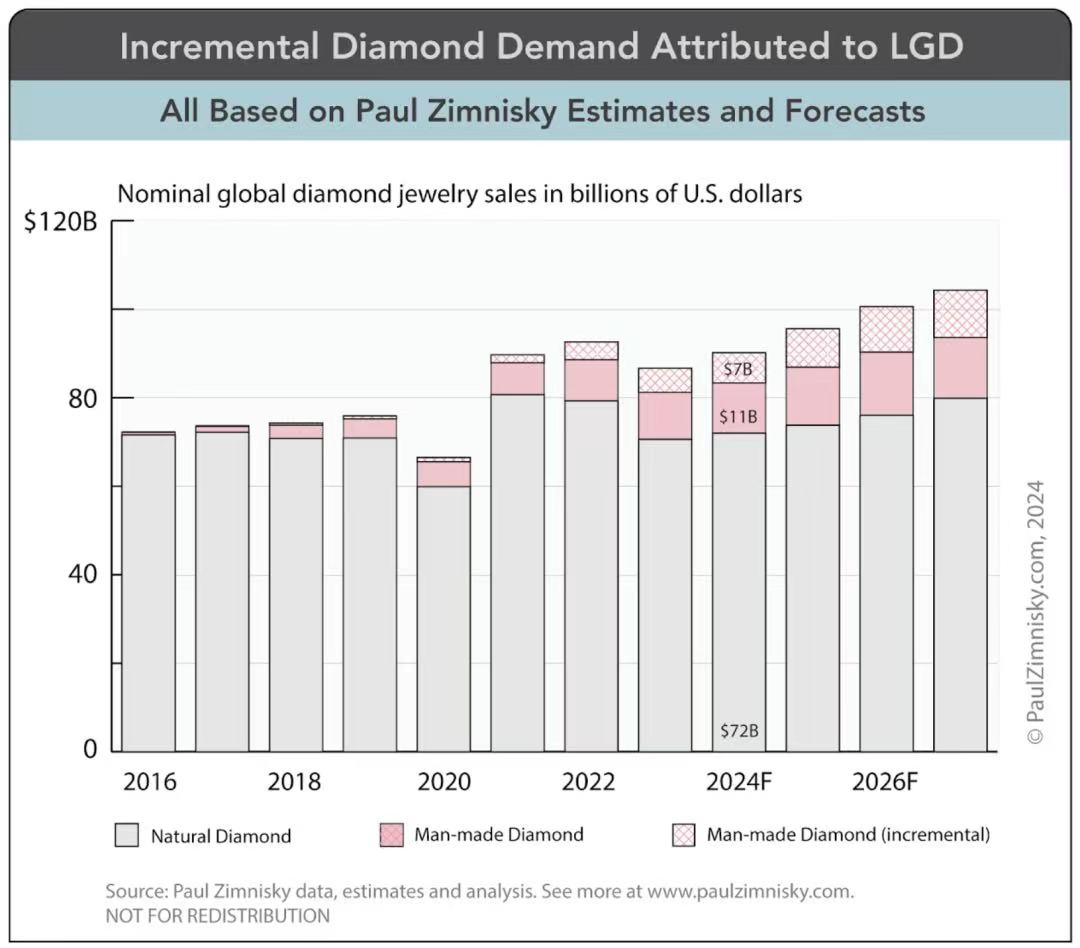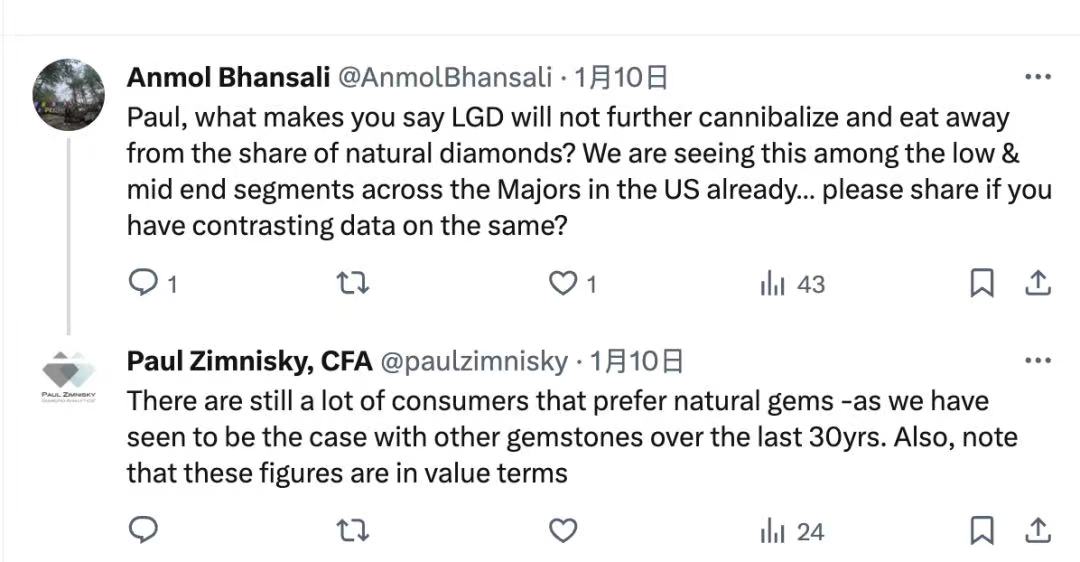In the current international public opinion, the saying that "cultivating diamonds to erode the natural diamond market" is very "popular". There are many reasons behind this statement: concerns about the declining demand for natural diamonds, the protection of vested interests, and human dependence on "natural" and "rare", etc. It's all normal.
However, there are also quite a few practitioners who believe that the real meaning of cultivating diamonds is to provide a new choice for the diamond consumer market, thus helping to expand the size of the entire diamond market. Especially when the price difference between cultivation and nature is magnified to a certain extent, many consumers who originally had the desire to buy but had insufficient budget could get their favourite diamond products.
As for the erosion of the natural diamond market, it is inevitable - especially in the current primary stage of development.

Paul Zimnisky
Paul Zimnisky, an analyst we are familiar with, published an interesting article the day before yesterday, analysing and predicting the contribution of cultivating diamonds to the market increment.
As a senior analyst who has been observing the international diamond industry for a long time, the basis of many views of Ginniski is the rules and development history of the natural diamond industry.
However, through the communication in recent years, we still believe that compared with other "analysts" or "analytic organisations", Ginnisky's tolerance and objectivity are relatively more prominent. Therefore, this article will interpret his views on the incremental contribution of cultivating diamonds. Please refer to it.
Ginniski calculates on the basis of sales value (or "market value") and believes that 60% of cultivated diamonds will be "competitive with the natural diamond market" in 2026. In other words, he believes that 40% of the cultivated diamonds sold in 2026 are conducive to market growth.
"(For the diamond market) If diamonds are not cultivated, these sales will not exist."
Of course, as he said in the article, the premise of this prediction is that the diamond market is not a "zero-sum market", that is, every cultivated diamond sold does not mean that one less natural diamond will be sold.

Cultivate diamond sales and incremental contributions in 2016-2026.
Unit: $1 billion. Source: Paul Zimnisky
As can be seen from the above figure, Ginnisky expects the total global sales of cultivated diamond jewellery to reach 18 billion US dollars in 2024, of which $7 billion is an "incremental market".
From 2016 to 2026, the contribution of cultivating diamonds to the incremental market is constantly expanding.
Ginniski insists that consumers' views on natural diamond jewellery are different from those on cultivating diamond jewellery. Especially when the price of cultivated diamonds continues to fall, this conceptual difference will become more obvious when consumers know that the price of a cultivated diamond is 30% or 20% of natural diamonds of the same grade.
In addition to the changes in market concepts caused by price trends, the evolution of science and technology is also a factor that needs to be considered for cultivating the diamond industry.
The article believes that head producers will continue to increase investment in scientific research to produce better economic effects (including the industrial field). At the same time, this will also create certain barriers for new entrants, so that the head manufacturer has greater pricing power.
Interestingly, Kinniski takes Chinese abrasive manufacturers as an example and supports the above-mentioned view of "pricing power" with the expression that "a few large factories supply 80%-90% of the world's products".
Back to the consumer market.
The diversity of fashion jewellery may be more suitable for the future development of cultivating diamonds. In some areas that cannot be met by natural diamonds, such as when customers need special colours and shapes, cultivating diamonds will play a greater role.
"Compared with imitation diamonds (such as mosanite, diamonds, etc.), cultivating diamonds will gain a greater market share."
"From the perspective of sales (not sales), cultivate diamonds as an artificial product, and their supply and sales coverage will be greater than that of natural diamonds." Original text: more widely supplied and sold than natural diamonds on a volume basis).
According to Ginniski's estimation, from the perspective of market value, the proportion of diamonds cultivated worldwide is only about 20%. For an industry whose output doubles every two years, this is not a particularly positive data.
"Perhaps part of the reason is that the current cultivated diamond retail market is still centred on the United States, while other countries and regions have not been fully developed."

Source: x
Generally speaking, Ginniski's article is more inclined to "coexist and complement each other of the two types of diamonds", which is a relatively soft view.
But this does not mean that everyone agrees with him. For example, someone questioned it on Twitter (i.e. "x") (as shown in the picture above): Why do you say that cultivating diamonds will not further eat the share of natural diamonds? We have seen this phenomenon in the middle and low-end markets of the United States. Do you have any relative data?
Ginniski's answer is: There are still many consumers who prefer to buy natural gems... In addition, please note that the numbers I mentioned are value (not sales)
The world is very big and there are many people. Everyone can have their own views and freedom of expression. In the daily news we receive, many people still insist that "cultivating diamonds is a fake diamond", and many people still think that "you need to eat each other to survive".
In fact, there are not many feelings in the business world. It is more about the desire for money and power, and the fear of losing money and power. Especially the latter, it can make people lose the so-called rationality and inclusiveness.
But anyway, we still insist that the two factions should reduce conflicts and develop harmoniously. Moreover, the incremental effect of cultivating diamonds on the global diamond retail market does exist, which is a positive thing for the diamond industry.
People will see, "The whole cake is getting bigger." ( Original text: "The total pie is growing.")
Source: Diamond Observation
